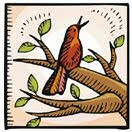Benvie, Sam. Encyclopedia of North American Trees. Buffalo, NY: Firefly, 2000.
Brockman, C. Frank. Trees of North America: A Guide to Field Identification. Ed. Herbert S. Zim. New York: Golden, 1986.
Cliburn, Jerry, and Ginny Clomps. A Key to Missouri Trees in Winter: An Identification Guide. Conservation Commission of the State of Missouri, 1980.
Collingwood, G. H., Warren David Brush, and Devereux Butcher. Knowing Your Trees. Washington: American Forestry Association, 1978.
Dirr, Michael. Dirr's Hardy Trees and Shrubs: an Illustrated Encyclopedia. Portland, Or.: Timber, 1997.
Elias, Thomas S. The Complete Trees of North America; Field Guide and Natural History. New York: Book Division, Times Mirror Magazines, 1980.
Grimm, William Carey. The Book of Trees;. Harrisburg, PA: Stackpole, 1962.
Hightshoe, Gary L. Native Trees, Shrubs, and Vines for Urban and Rural America: a Planting Design Manual for Environmental Designers. New York: Van Nostrand Reinhold, 1988.
Little, Elbert L. National Audubon Society Field Guide to North American Trees. New York: Chanticleer, 1996.
Martin, Alexander C., Herbert S. Zim, and Arnold L. Nelson. American Wildlife and Plants. New York: McGraw Hill, 1951.
Mitchell, Alan F., and David More. The Trees of North America. New York, NY: Facts On File Publications, 1987.
Randall, Charles E. Enjoying Our Trees. Washington: American Forestry Association, 1969.
Settergren, Carl D., and R. E. McDermott. Trees of Missouri. Columbia: University Extension, 1995.
Sternberg, Guy, and James W. Wilson. Native Trees for North American Landscapes: from the Atlantic to the Rockies. Portland: Timber, 2004.
Wharton, Mary E., and Roger W. Barbour. Trees and Shrubs of Kentucky. Lexington: University of Kentucky, 1973.
Wyman, Donald. Trees for American Gardens. New York: Macmillan, 1965.
 Isabella Bird visited the pine forest near the treeline in Estes Park, Colorado, in the early 1870's and recorded her observations:
Isabella Bird visited the pine forest near the treeline in Estes Park, Colorado, in the early 1870's and recorded her observations:

 "The power to recognize trees at a glance without examining their leaves or flowers or fruit as they are seen, for example, from the car-window during a railroad journey, can only be acquired by studying them as they grow under all possible conditions over wide areas of territory. Such an attainment may not have much practical value, but once acquired it gives to the possessor a good deal of pleasure which is denied to less fortunate travelers."
"The power to recognize trees at a glance without examining their leaves or flowers or fruit as they are seen, for example, from the car-window during a railroad journey, can only be acquired by studying them as they grow under all possible conditions over wide areas of territory. Such an attainment may not have much practical value, but once acquired it gives to the possessor a good deal of pleasure which is denied to less fortunate travelers."
4 comments -- please add yours:
I always have liked weeping willows despite knowing about all their foibles too...
I grew up in Christian County, in Hopkinsville near Dink Embry's radio station on Buttermilk Rd.
Not there now though. ;)
Thanks for visiting, speecialpants. I still love the way they look, and I'm hoping that other one will last a few more years. We are thinking about having the broken-up one taken down this summer so we can plant something else there. My husband thinks he wants a bald cypress, and it would probably do well there.
At my former home in Knox County I made the mistake of planting a row of hybrid willows, which were advertised in a nursery catalog as being a fast-growing screen tree.
That they were; five years later they were thirty feet tall, but to my chagrin I found that they had extended a shallow layer of roots under our entire garden, which was some distance away!
I cut them down and herbicided the sprouts with RoundUp; it took a couple of years to kill them out completely.
A bald cypress is definitely a better choice!
Larry, thanks for your comment. Honestly, we have made our share of tree mistakes. We put in a row of hybrid poplars in a narrow area between us and a gravel road, to try to block some of the dust. They have served their purpose, I admit, but several have died in just 15 years though they were supposed to be "long-lived" hybrids that lived 30 years or more.
Post a Comment